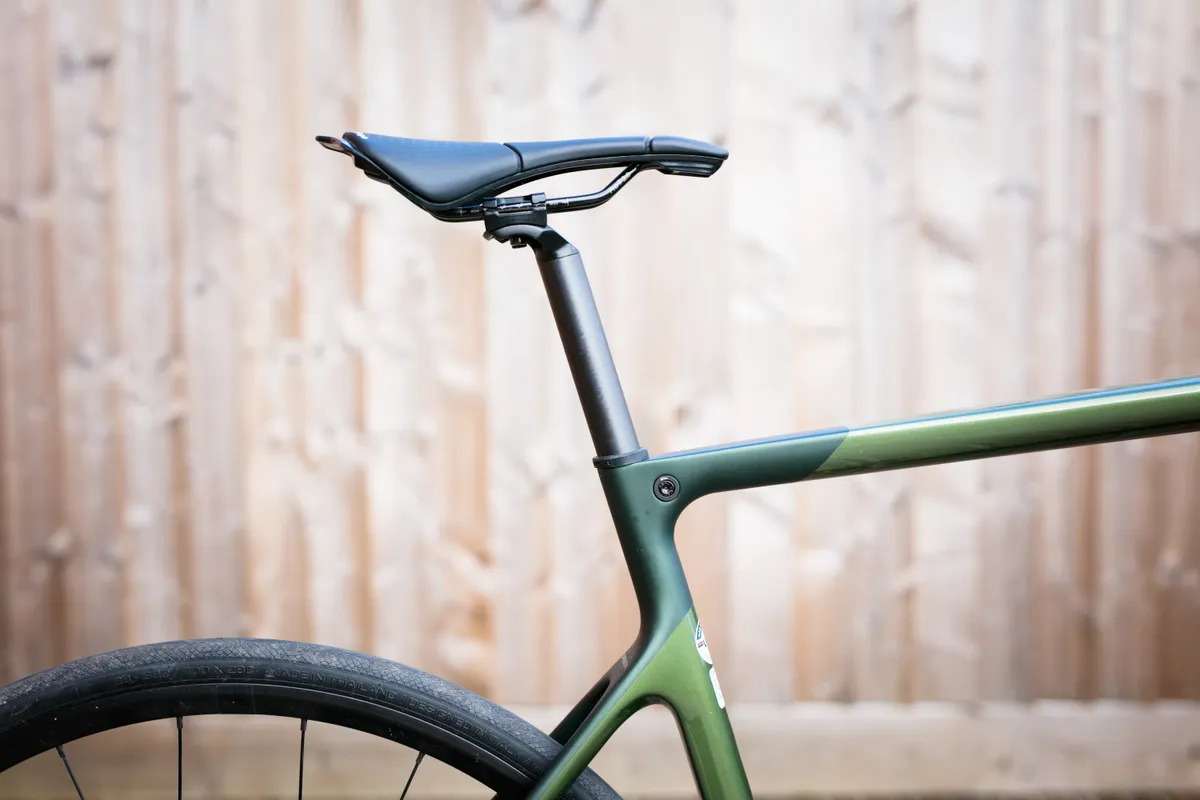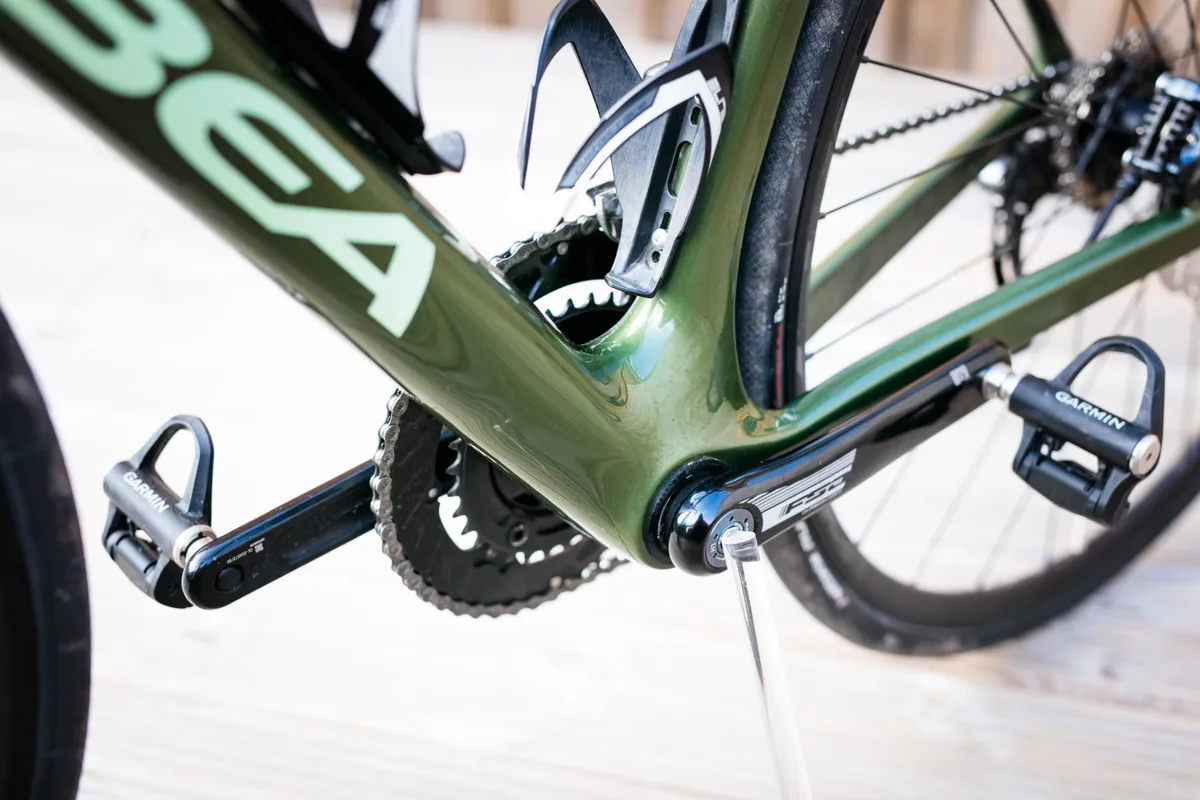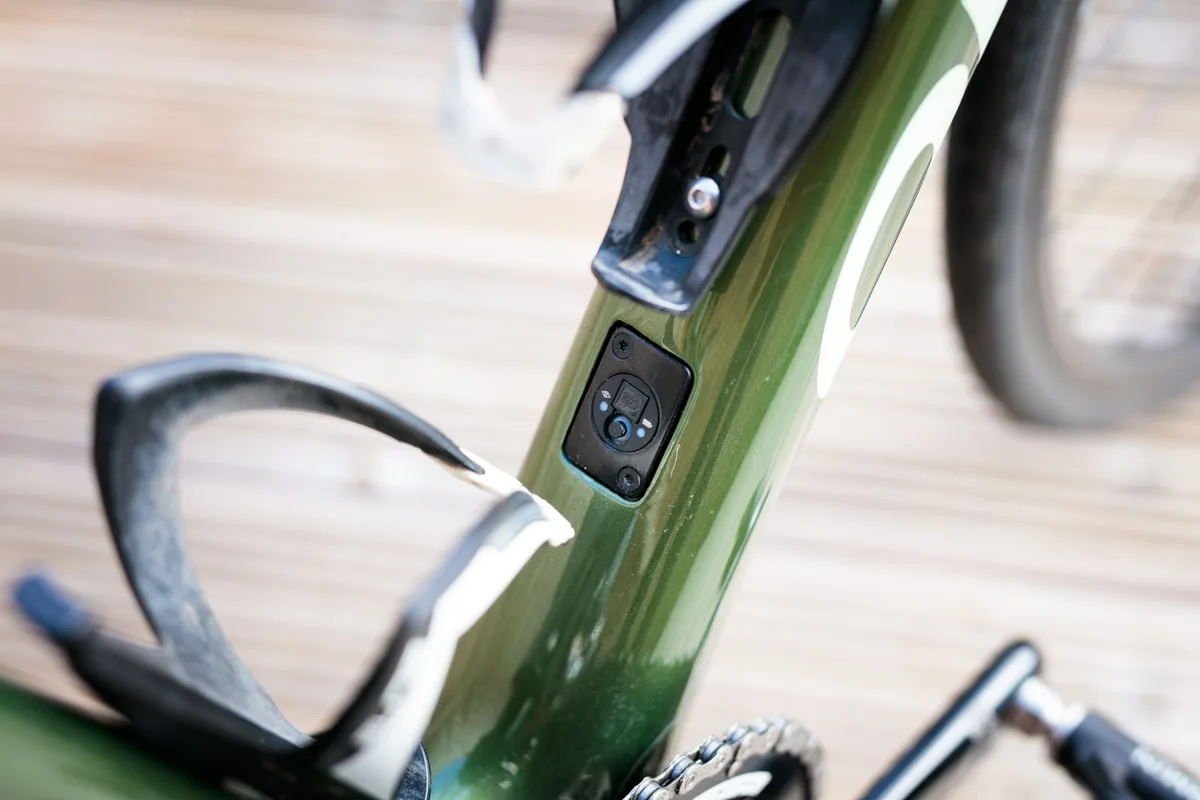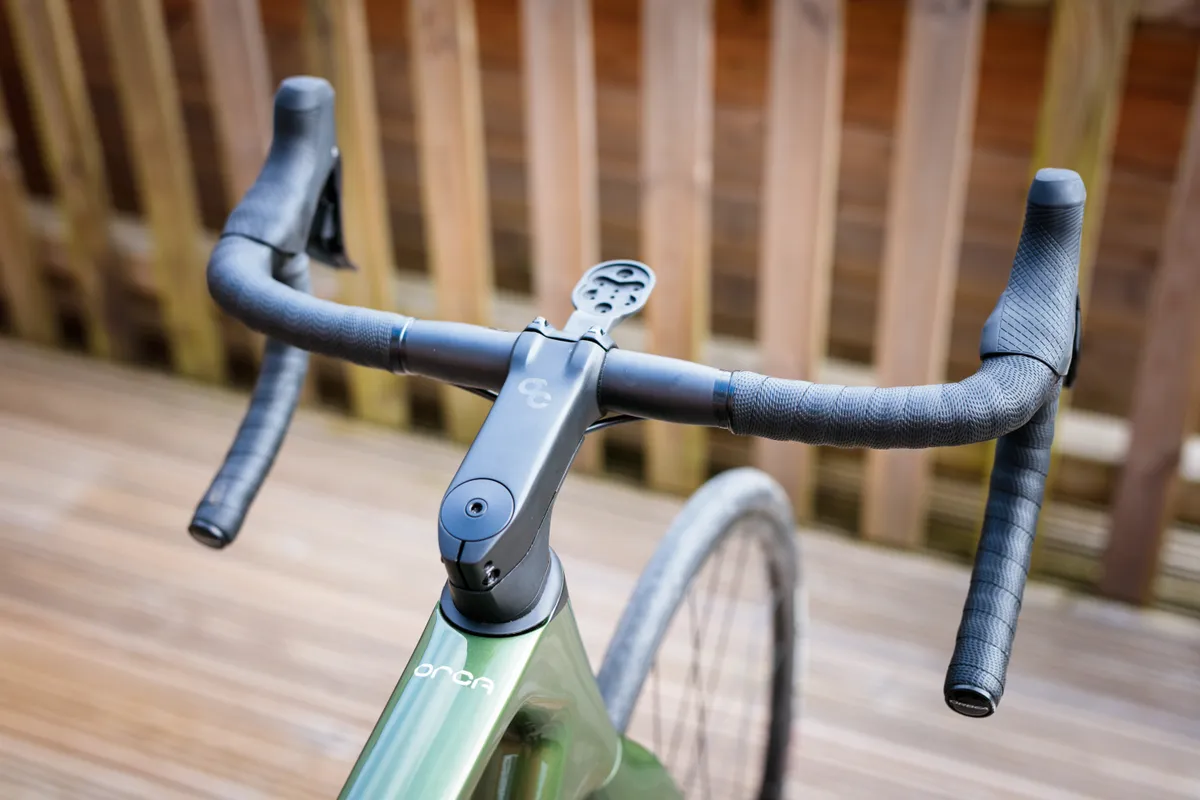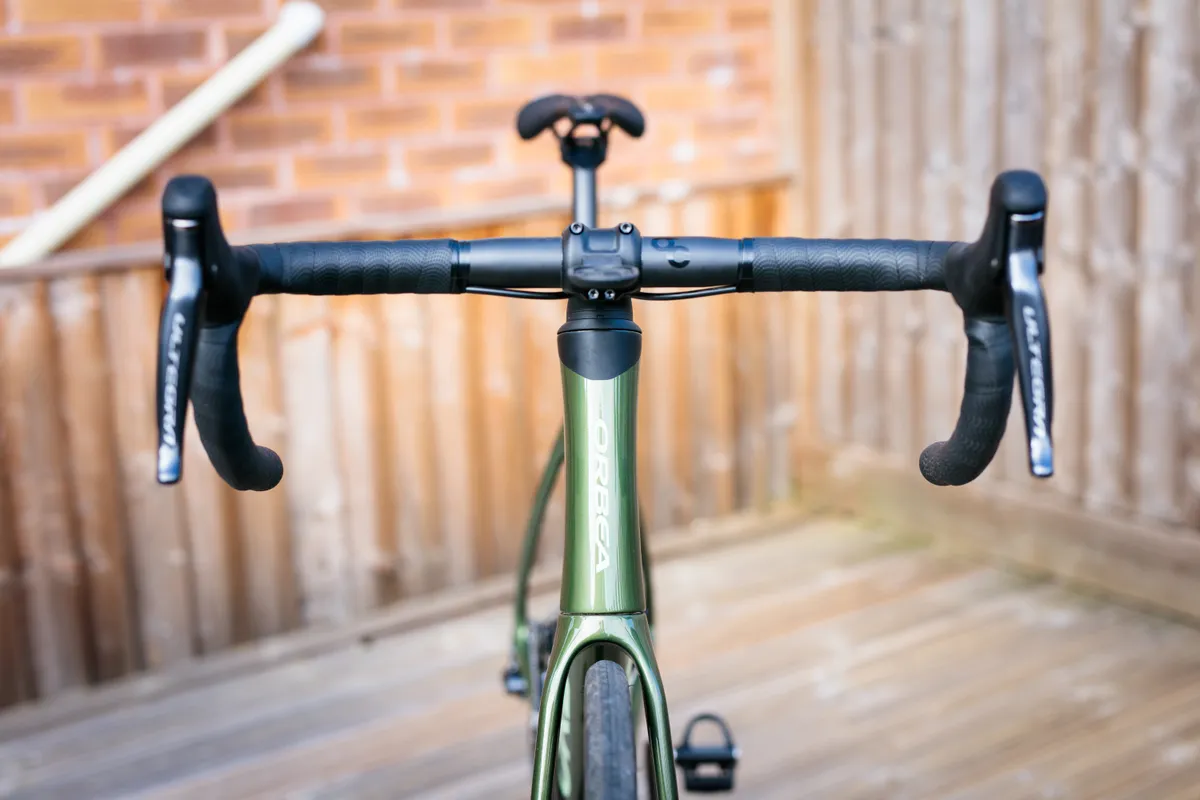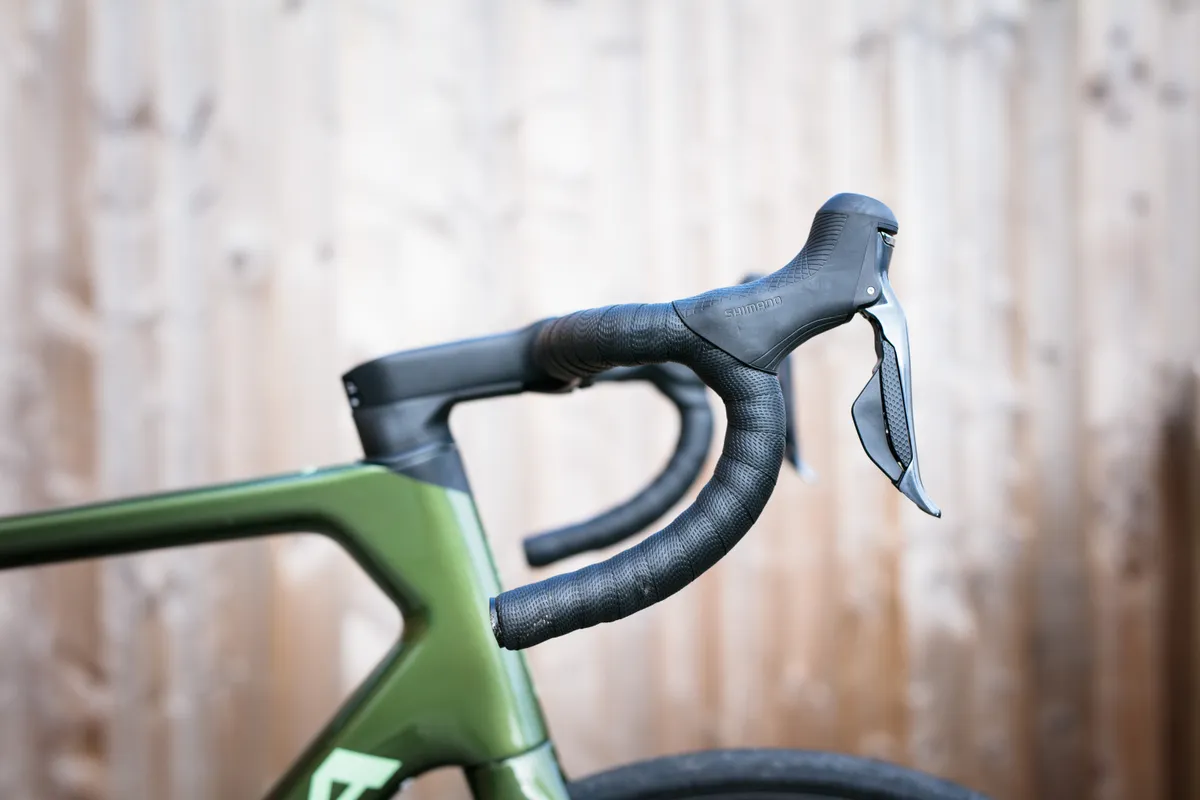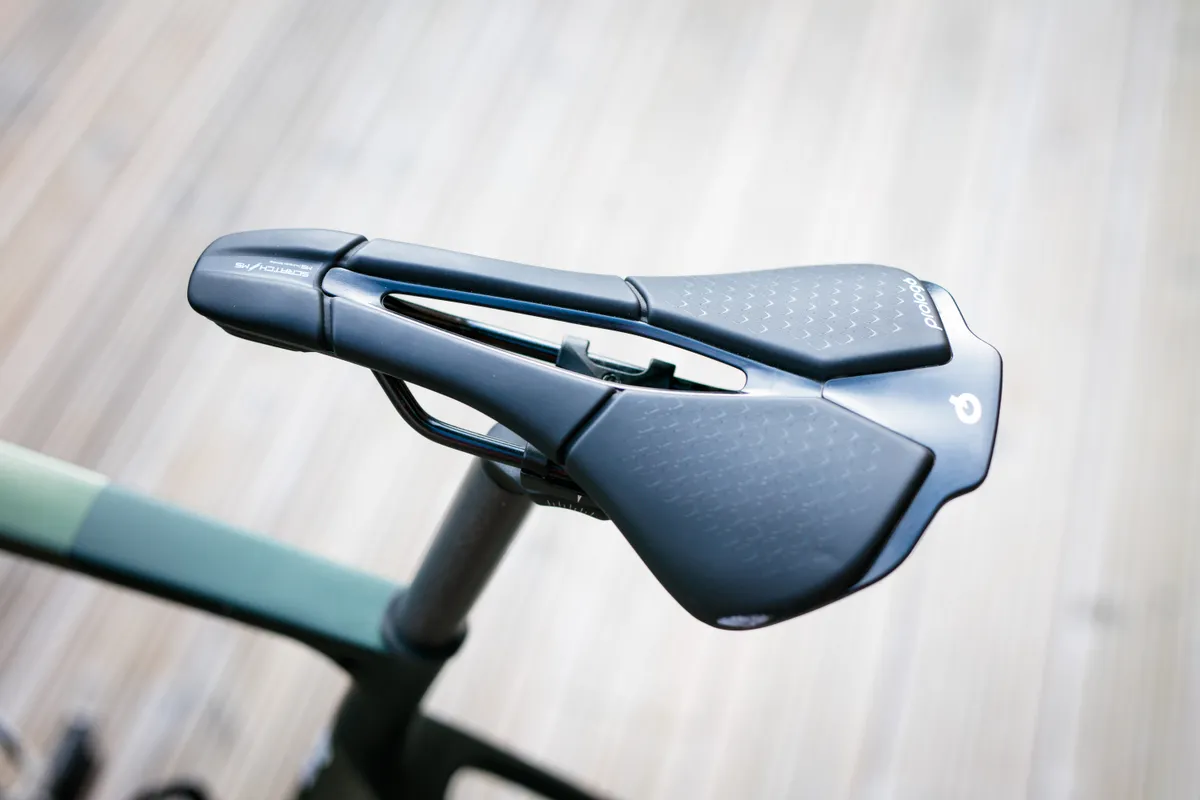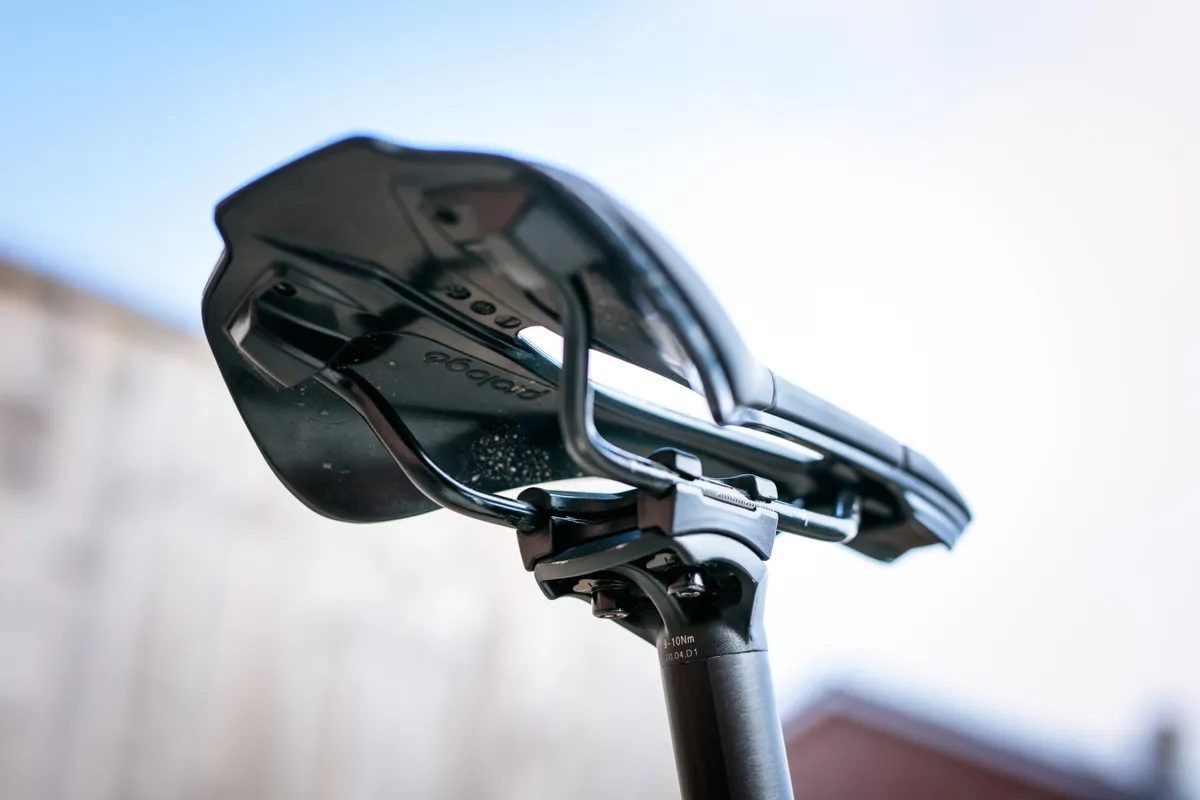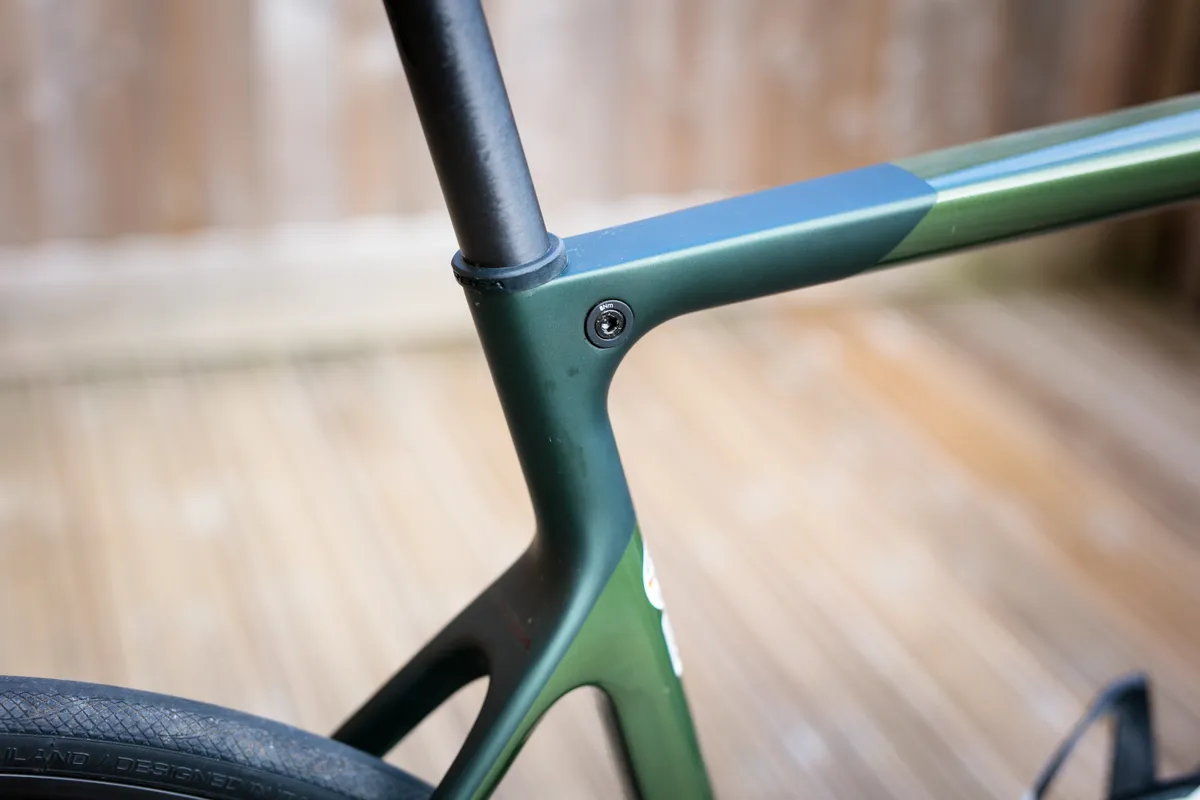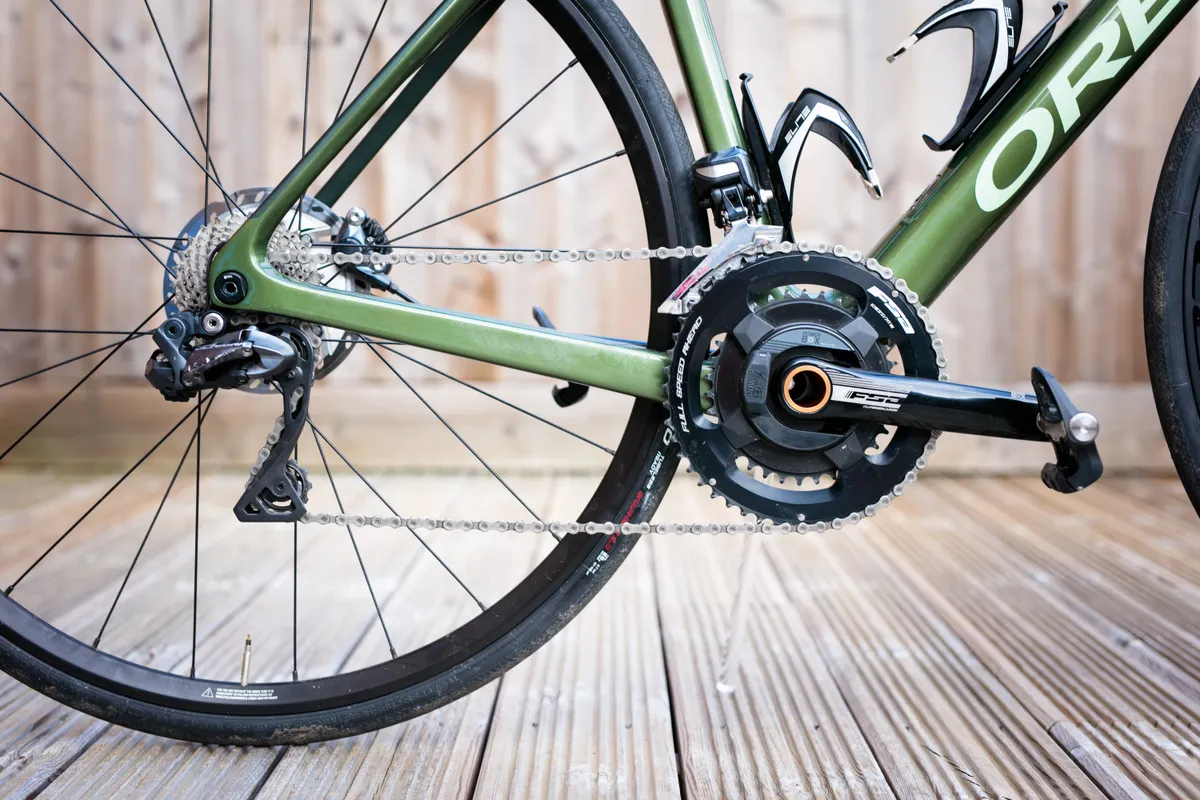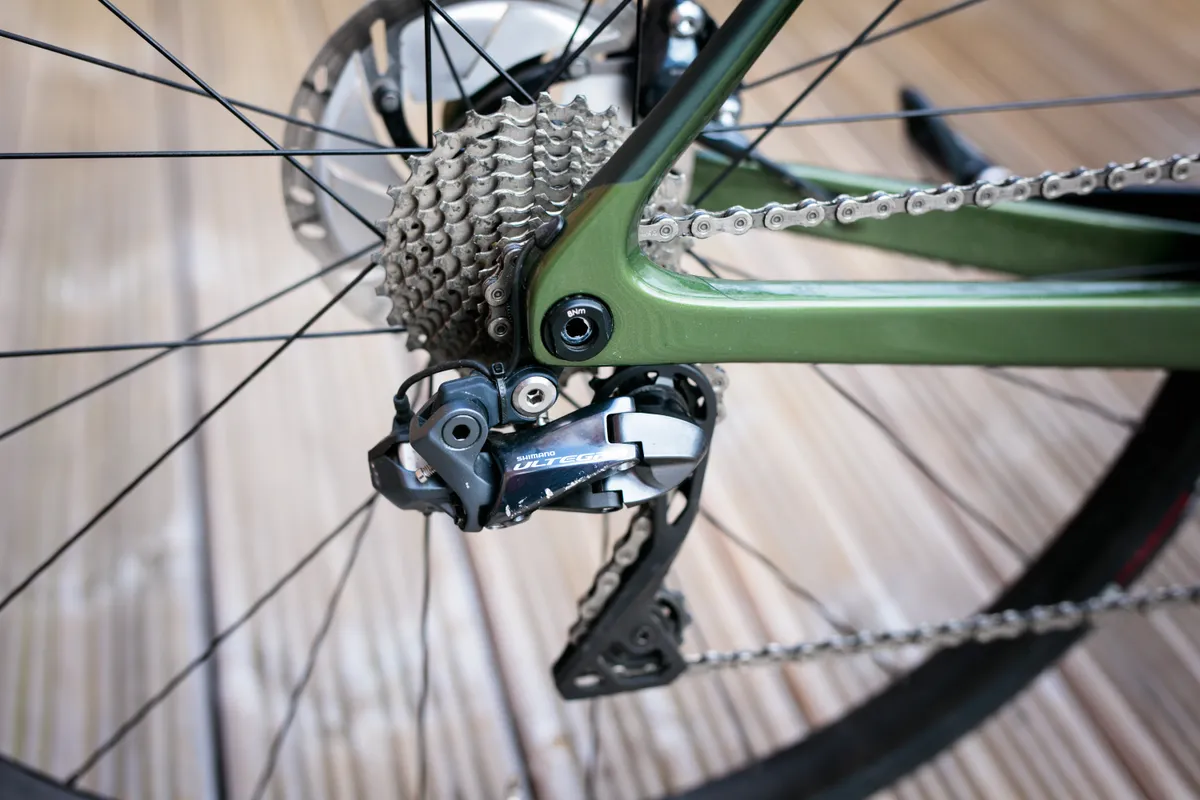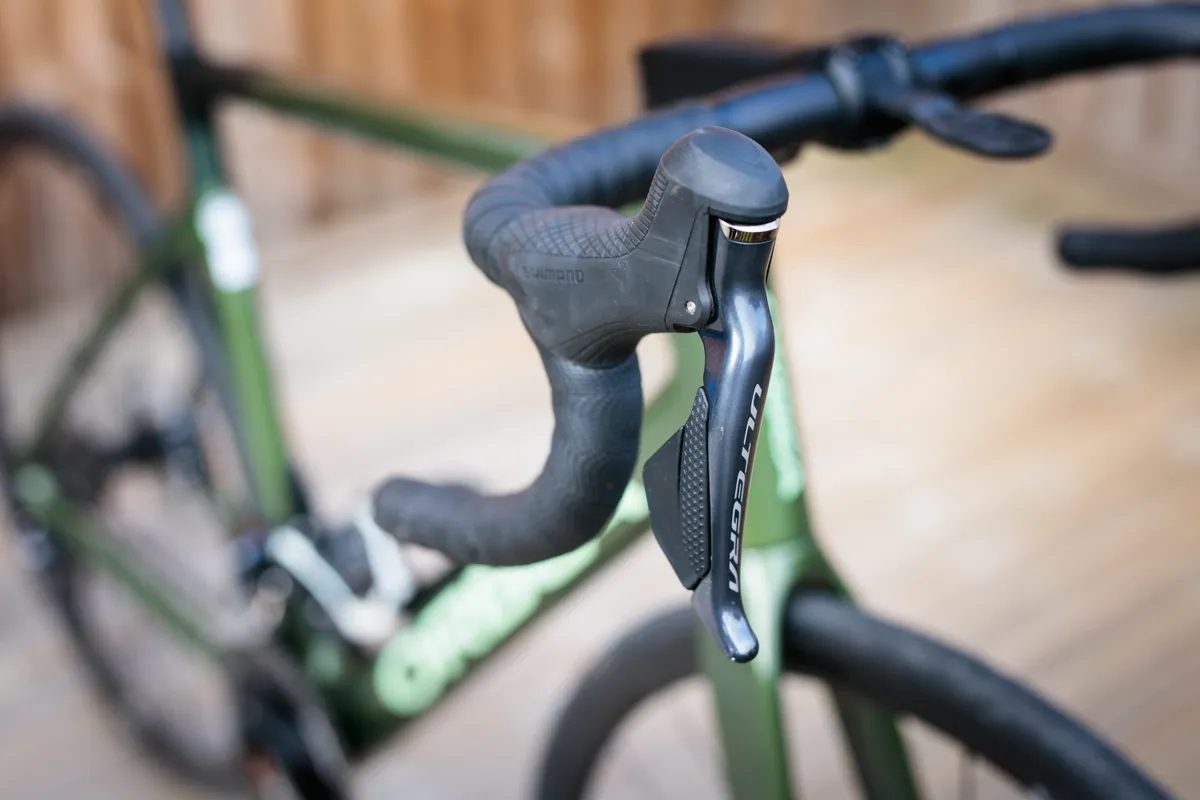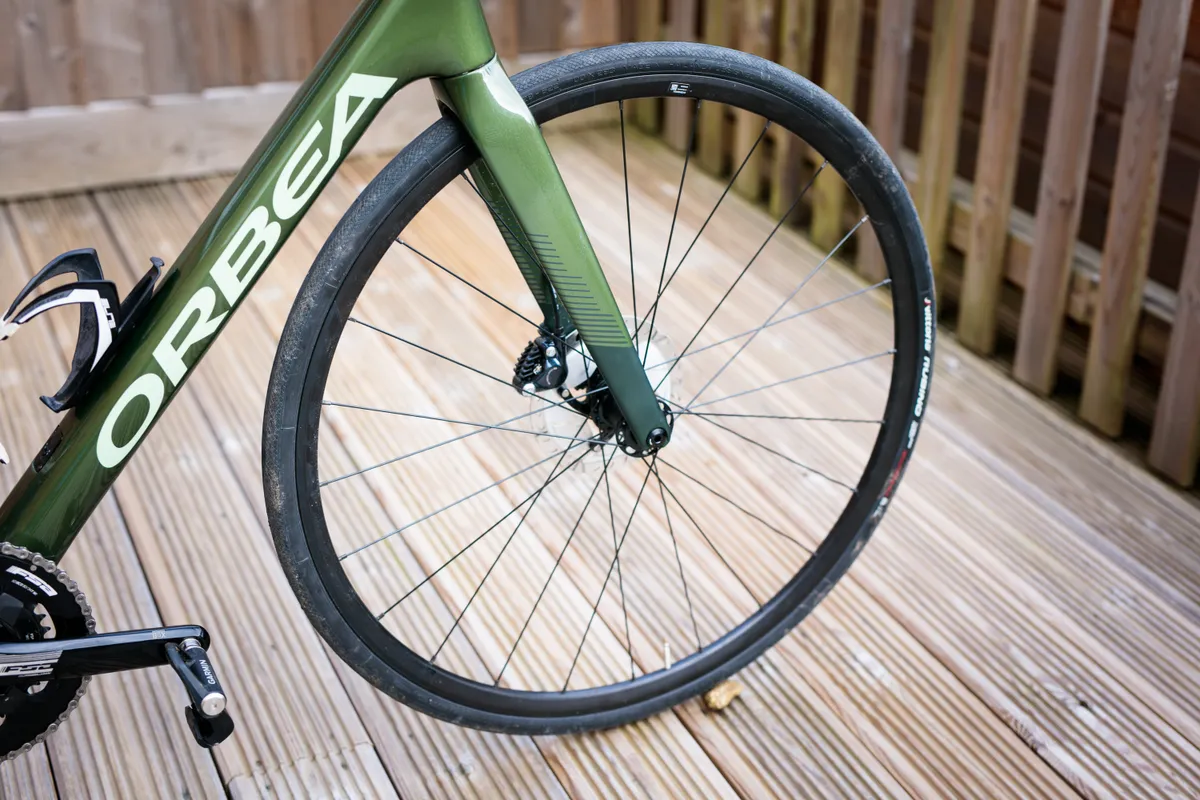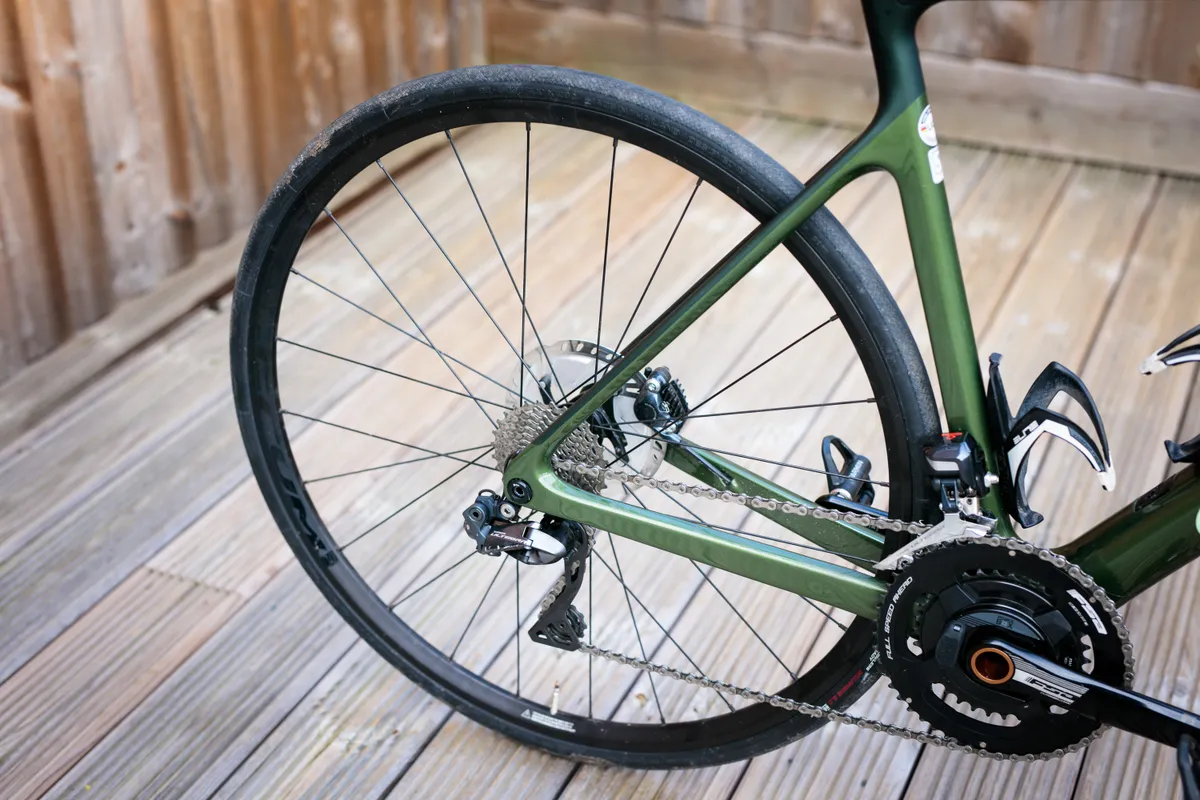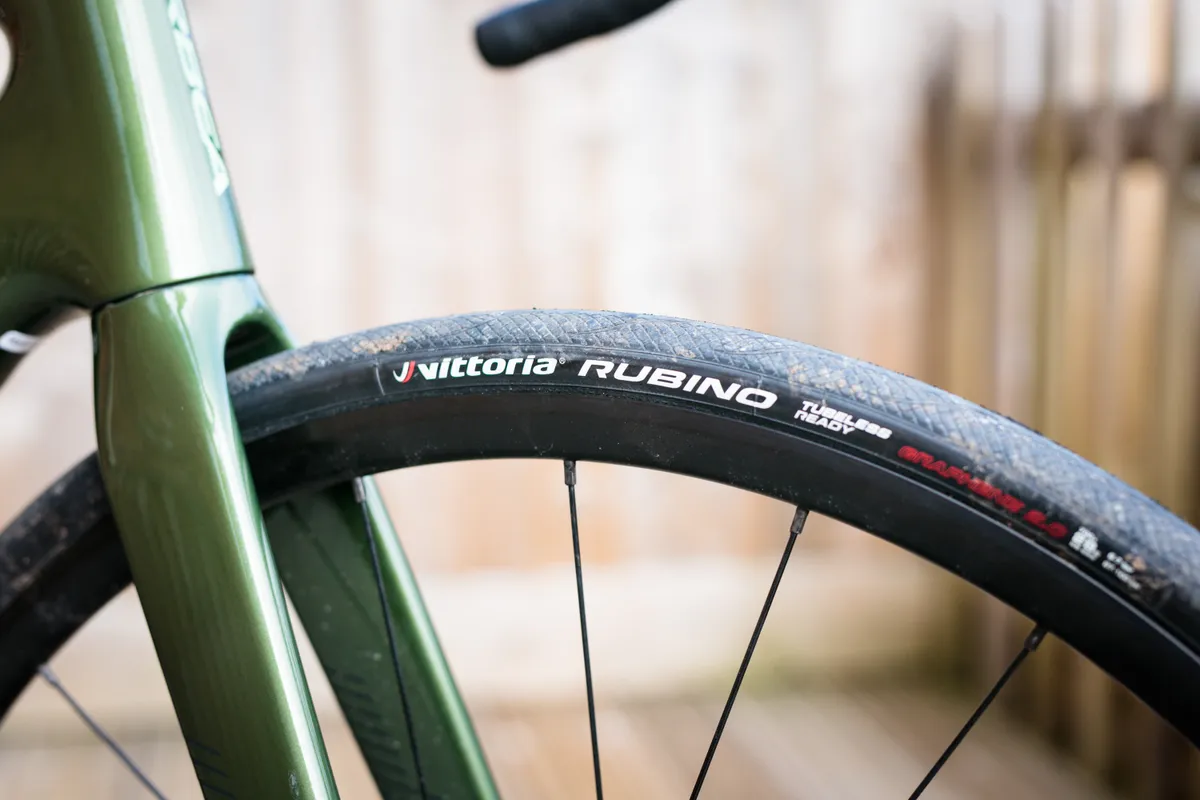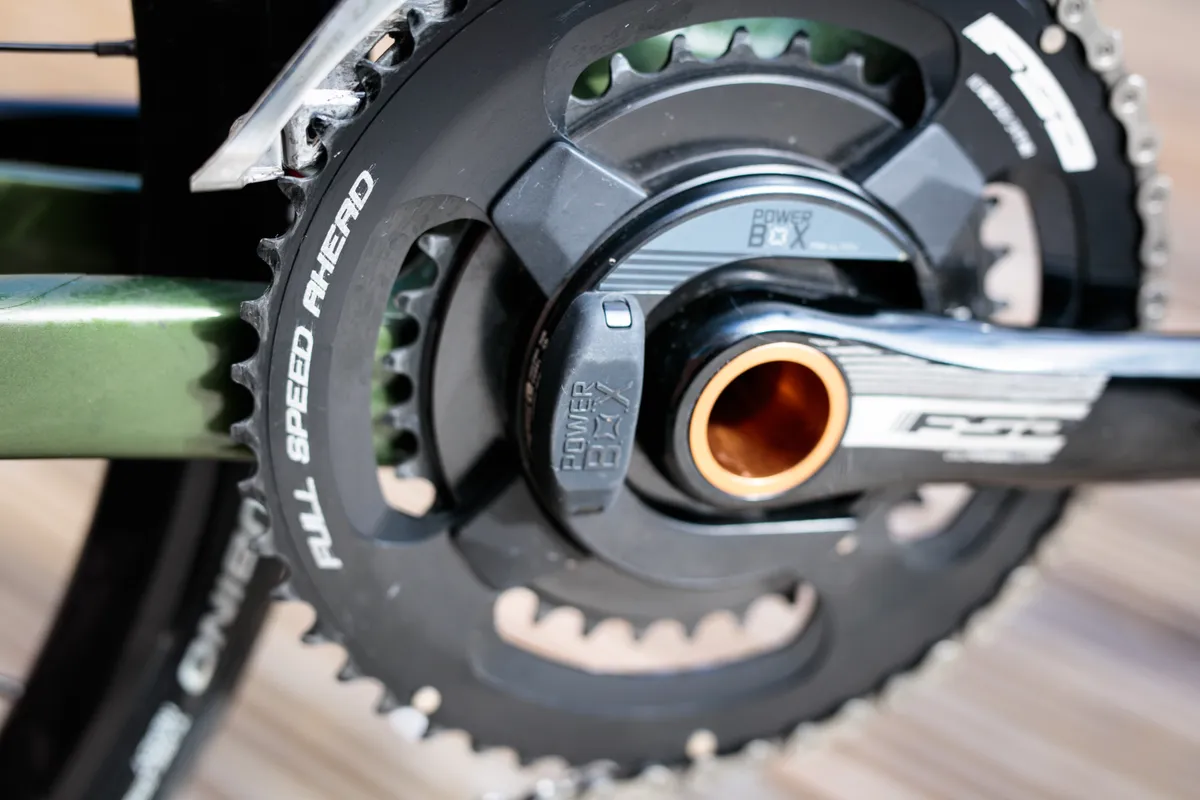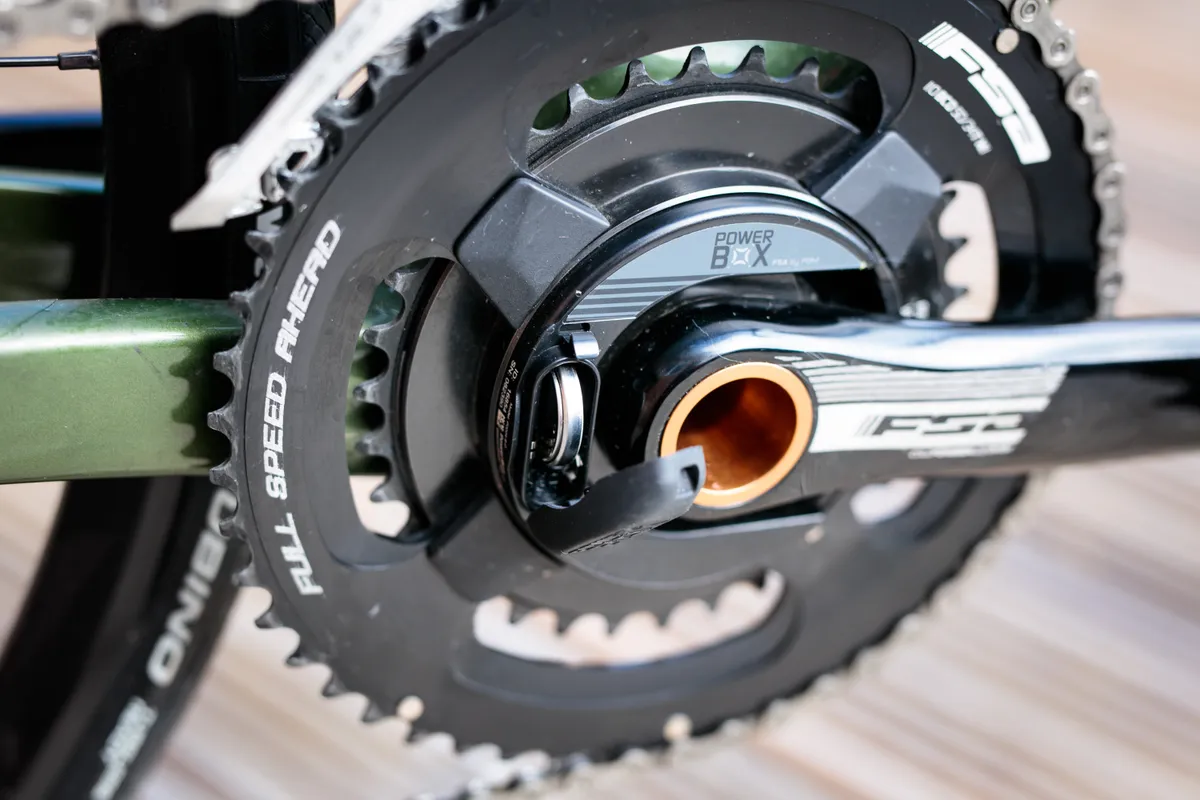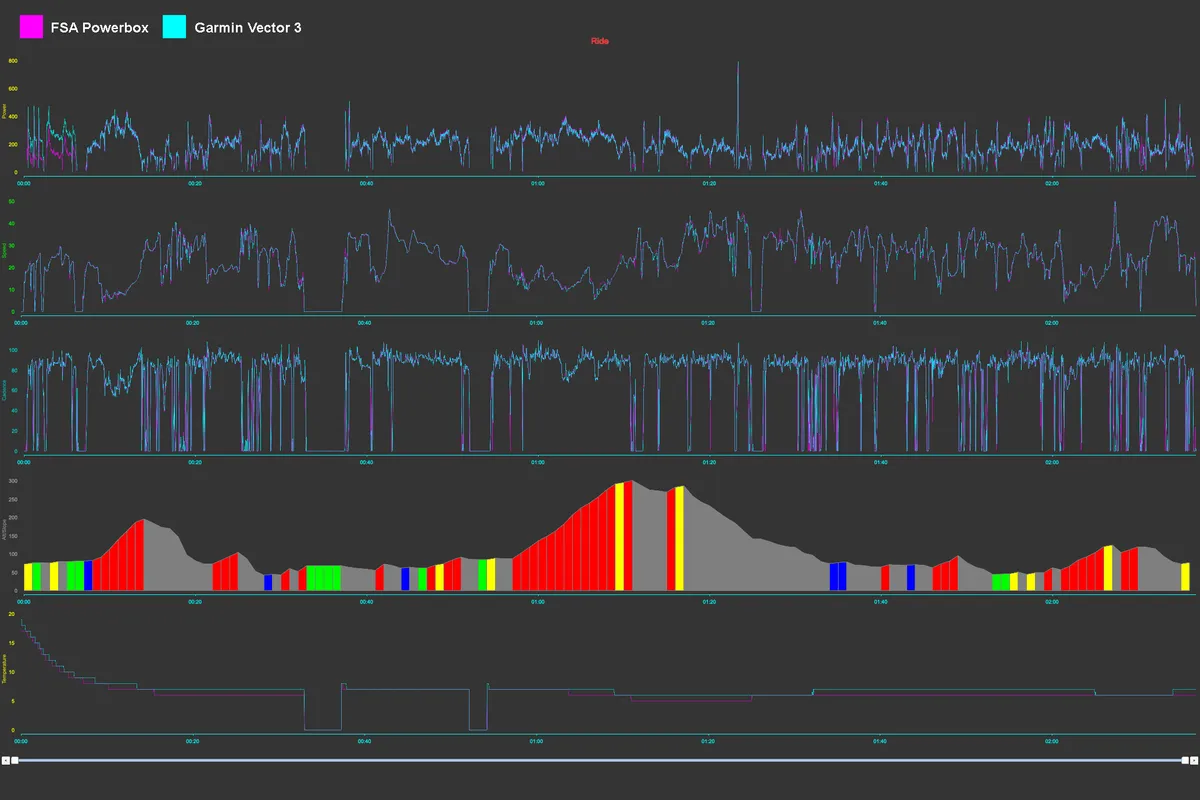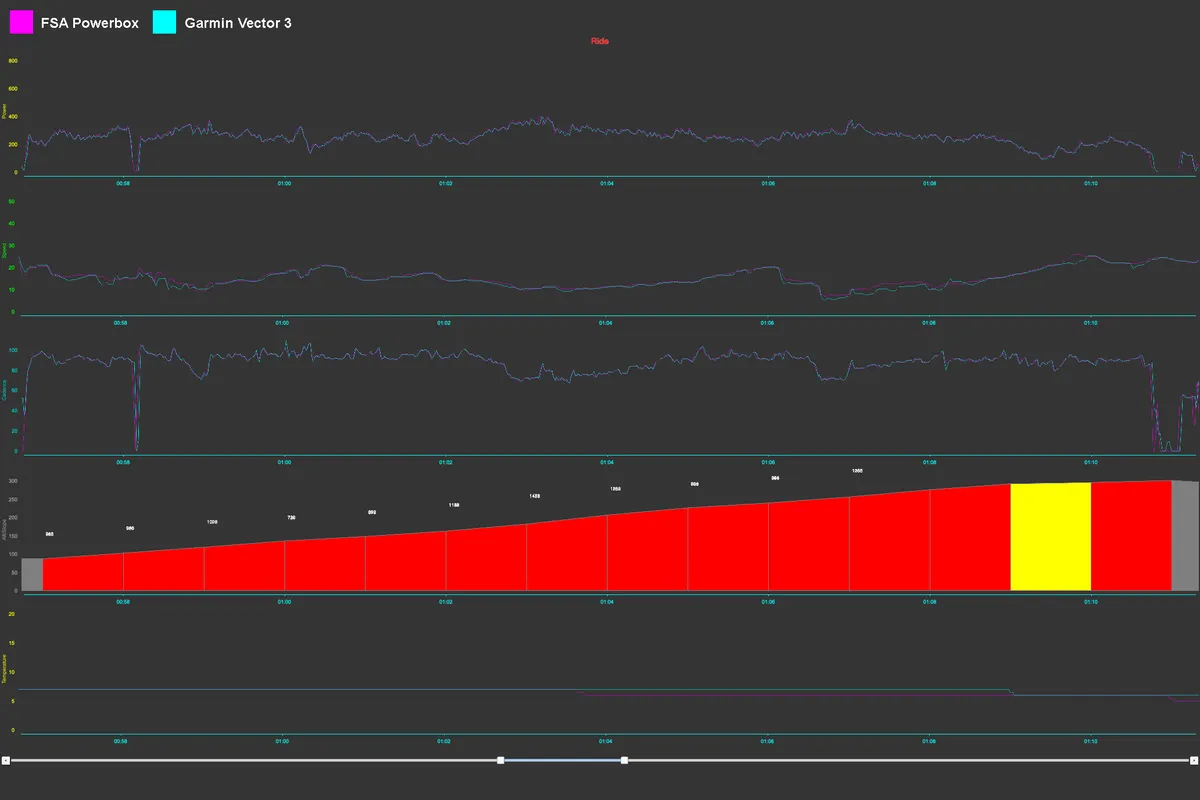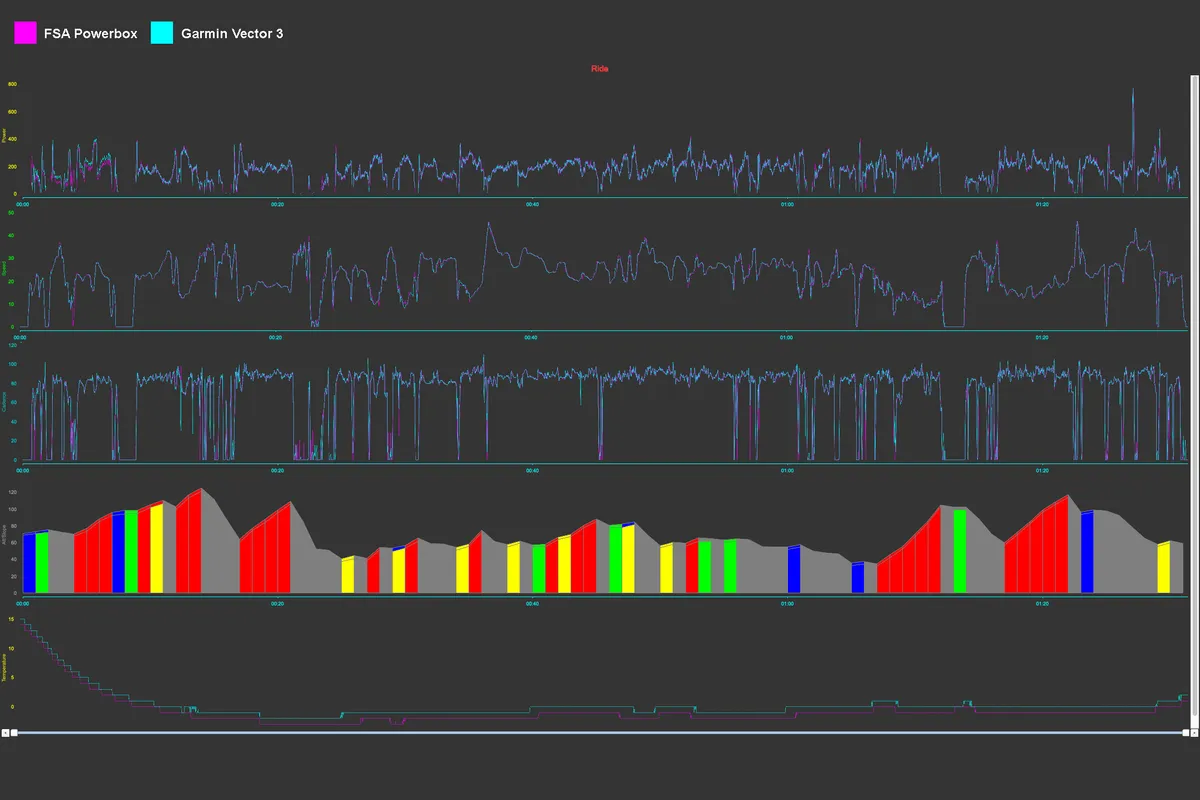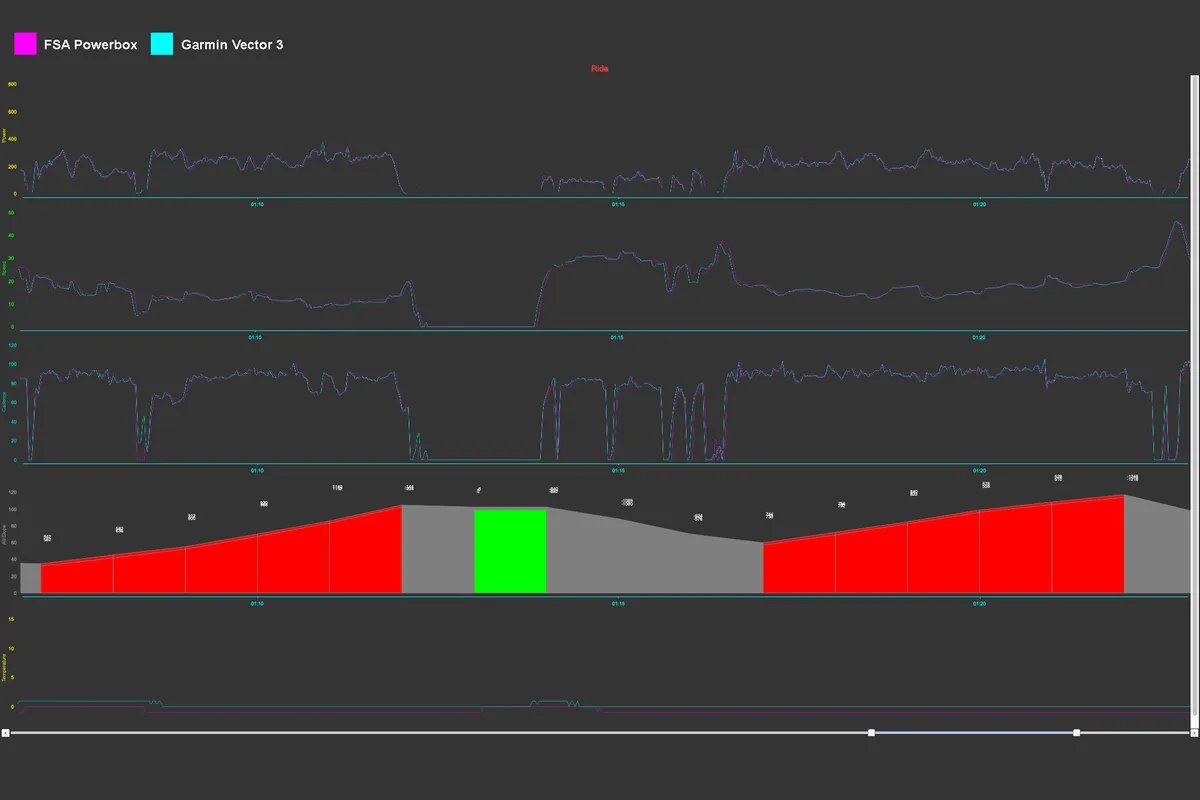The Orbea Orca OMR M20i Team is an all-round, unisex road bike that leans into endurance bike territory, without resorting to novel, or potentially complicated, solutions for adding comfort.
Its elegant looks, use of standard parts, neat cable routing and customisation options will likely hold great appeal to cyclists who want a comfortable, simple and versatile bike.
But, in this build – which costs £4,728 – a set of disappointingly average wheels and tyres, make it feel a little underwhelming on the road.
Orbea Orca OMR frameset
As the second-tier frameset in Orbea’s Orca range, the OMR differs from the top-spec Orca OMX frameset in a few ways, most of which dial down its raciness and turn up comfort and versatility levels.
The geometry is unchanged from its more premium sibling, sitting at the racier end of endurance road bikes, alongside bikes such as the Cannondale Synapse or Cervélo Caledonia.
| Size (cm) | 47 | 49 | 51 | 53 | 55 | 57 | 60 |
|---|---|---|---|---|---|---|---|
| Seat tube (mm) | 440 | 460 | 480 | 500 | 520 | 540 | 570 |
| Effective top tube (mm) | 510 | 523 | 535 | 548 | 560 | 576 | 590 |
| Head tube (mm) | 105 | 113 | 130 | 148 | 168 | 186 | 213 |
| Chainstay (mm) | 408 | 408 | 408 | 408 | 408 | 408 | 408 |
| BB Height (mm) | 267 | 267 | 267 | 269 | 269 | 269 | 269 |
| BB Drop (mm) | 72 | 72 | 72 | 70 | 70 | 70 | 70 |
| Wheelbase (mm) | 972 | 976 | 980 | 981 | 991 | 1002 | 1016 |
| Head angle (degrees) | 71º | 71.5º | 72.2º | 72.8º | 73º | 73.2º | 73.2º |
| Seat angle (degrees) | 74.5º | 74º | 73.7º | 73.5º | 73.5º | 73.2º | 73.2º |
| Standover (mm) | 735 | 747 | 766 | 787 | 807 | 825 | 851 |
| Reach (mm) | 367 | 372 | 377 | 382 | 388 | 395 | 401 |
| Stack (mm) | 513 | 522 | 540 | 559 | 579 | 597 | 623 |
| Rake (mm) | 48 | 48 | 48 | 43 | 43 | 43 | 43 |
It also retains its good looks, though the frame tube shapes have, for the most part, been modified from the aero-optimised kammtails found on the Orca OMX to be slightly more rounded.
The bottom bracket is a BB386 EVO press-fit design. It’s arguably not as user-friendly as a threaded bottom bracket, but it gave me no trouble during testing and is adaptable to fit a wide variety of cranks and axles.
Tyre clearance is increased to allow for tyres up to 35mm wide, which is up 3mm from an already healthy 32mm on the Orca OMX.
This is very welcome because swapping in larger tyres will likely massively improve the bike’s ability on mixed terrain. It’s gravel-adjacent, as the cool kids might say.
Despite this increased tyre clearance, the Orca OMR frameset doesn’t come equipped with mudguard/fender mounts.
Though still somewhat of a rarity on carbon road bikes in general, a few other recently-released endurance road bikes, such as the Trek Domane, Merida Scultura Endurance, Ribble Endurance SL Disc and Cervélo Caledonia, are showing it’s entirely possible to integrate mudguard mounts into a carbon frame unobtrusively.
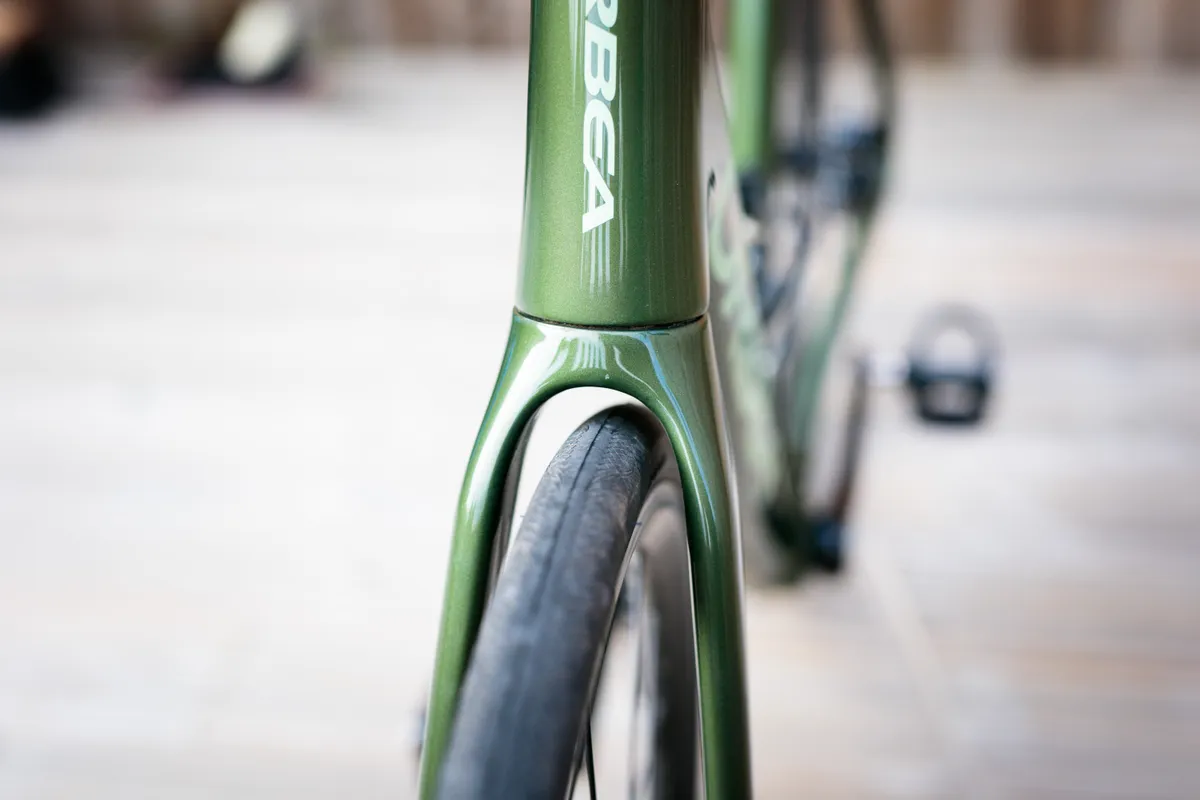
I suspect they’re omitted because Orbea sees its Orca series bikes as ‘race/performance bikes’, and I won’t argue with the fact that mudguards aren’t generally something most cyclists put on a no-compromise speed machine.
The Orca OMR doesn’t really feel like one of those, though.
It’s slightly higher and shorter than a pure race bike, like a Specialized Tarmac, and with its more rounded tubes and parts, and big tyre clearances, it feels like a much better fit in the endurance road bike category.
With the launch of bikes such as the Specialized Aethos, though, it’s clear there’s an enduring appetite for bikes like this, which use less aggressively sculpted tubes, standard parts, focus on ride quality and keep things simple.
Orbea Orca OMR M20i Team components
The Orca OMR comes with a slew of components made by Orbea, all of which look fantastic and perform excellently.
Both the Orbea ICR (Integrated Cable Routing) stem and carbon handlebar make for a very tidy cockpit. The ICR stem sits on a standard 1 1/8in steerer tube and routes the cables underneath the stem and proprietary headset spacer, and into an Acros headset specially designed to accommodate this kind of cable routing.
For my money, non-integrated systems such as this (it’s very similar to FSA’s SCR system seen on the excellent Merida Reacto 6000 I reviewed last year) strike a great balance between good aerodynamics, clean aesthetics, adjustability and user-friendliness.
Replacing headset bearings will inevitably mean disconnecting cables and all of that associated hassle, but that’s becoming par for the course these days. If you want hidden cables, that’s usually the trade-off. Adjusting the front end for bike fit reasons is likely within the remit of most amateur mechanics, though.
The 44cm (measured centre-to-centre) handlebar specced on this size 57cm test bike, for example, feels absurdly wide for this narrow-bodied tester, and are something I would be glad to have the ability to easily change were this my bike.
That said, Orbea’s MyO customisation programme – available on select models, directly from Orbea or via official Orbea dealers – actually gives you the option to swap components for fit reasons, too.
You can choose a different width option, for example, or Orbea’s OC Rise handlebar, which features 20mm of additional stack height and 5mm less reach for a more relaxed handlebar position.
It’s also worth noting that the MyO programme not only allows you to make component swaps and upgrades (the latter at additional cost), but also to customise the bike’s paint job at no extra cost. Orbea says there are more than 1.5 million colour combinations available, so the possibilities are extensive.
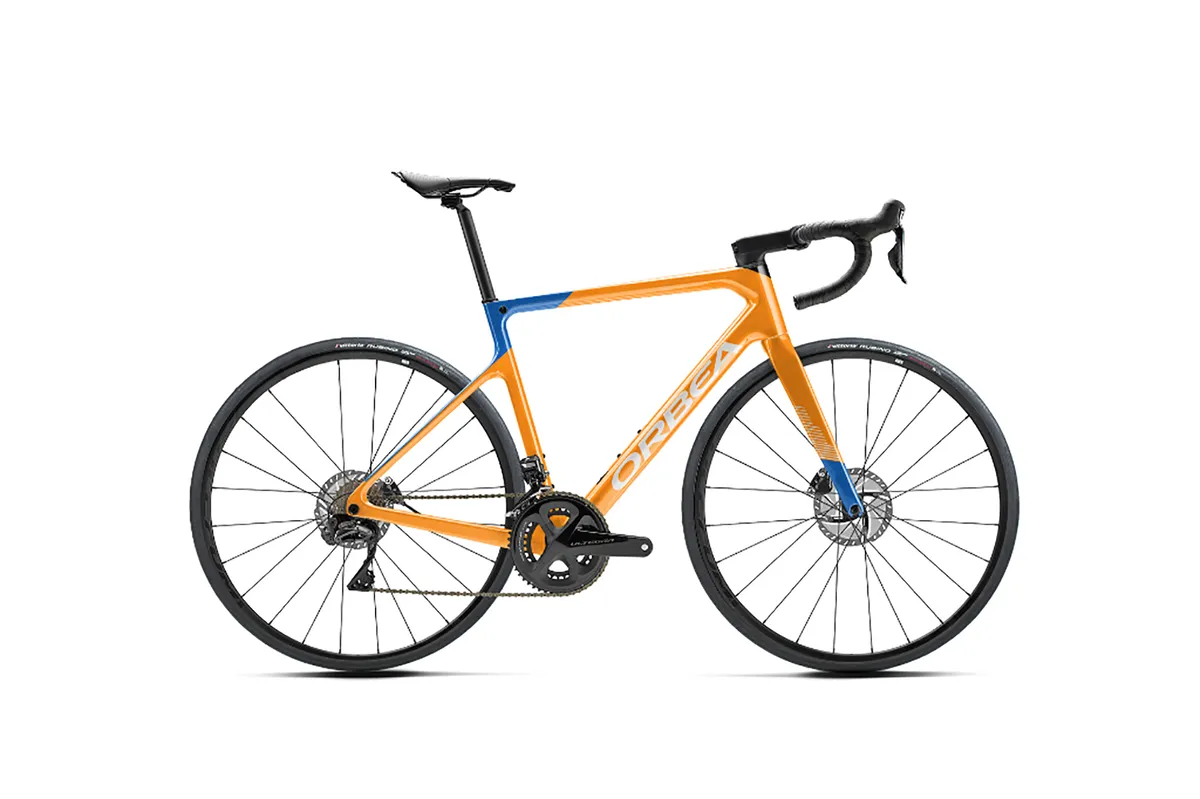
Sitting down to design and spec your dream bike is a real joy, and I wish more brands would offer services like this. I know it makes economic sense for brands to not offer this level of choice, but it’s so much better for the consumer.
Sadly, due to supply chain issues caused by the pandemic, lead times for MyO bikes have ballooned from around six to eight weeks to more like six months. As we’ve noted elsewhere, though, this sort of thing is an industry wide problem right now.
I found the Prologo Scratch-M5 PAS saddle to be exceptionally comfortable and, if you’re going to have a round seatpost, a standard 27.2mm seatpost like this is the right choice because they’re generally more comfortable than beefier 31.8mm options.
Like the front-end parts, the Orbea carbon seatpost is very elegant both in terms of form and function. Saddle adjustments are performed in a very simple fashion via two bolts underneath the saddle, and it provides plenty of comfort at the rear end, even with relatively little of it exposed.
All of these standard parts mean that, should any of them ever need replacing or upgrading down the line, compatible alternatives are likely to be easy to find.
Drivetrain, wheels and tyres
Apart from the the FSA Powerbox power meter crankset (specced here as an optional upgrade – more on this later), the drivetrain is made up of a complete Shimano Ultegra R8070 Di2 hydraulic groupset, with an 11-28-tooth cassette and a medium-cage rear derailleur (which can accommodate cogs up to 34 teeth in size).
Shifting performance, both front and rear, is genuinely exceptional. It’s certainly up there with Shimano’s flagship road groupset, Dura-Ace R9170 Di2.
Unless the 250g or so weight penalty is something you can’t tolerate, there’s little reason to choose the pricier groupset from a pure performance point of view.
The Fulcrum Racing 700 DB wheelset has a 22mm-deep rim and is built with 24 round, J-pull spokes, front and rear. The 19mm internal rim width is well-suited to the 28 to 35mm tyres this bike is designed to use. My experience with Fulcrum wheels leads me to believe these should be reliable performers in the long-term, too.
Nevertheless, they don’t add much to the performance of the bike beyond those basic attributes. With a claimed weight of 1,740g they’re average on the scales, and the shallow rim profile and round spokes don’t provide any aerodynamic benefit.
The tyres, meanwhile, are Vittoria’s Rubino IV G2.0 TLR, in a 700 x 28c size. Inflated to 60 PSI, they measure up pretty much bang-on 28mm wide. These are a cheaper, OEM (original equipment manufacturer) version of Vittoria’s Rubino Pro TLR tyre (which is available as an optional upgrade for £19).
Given the more expensive Rubino Pro version produces nearly double the rolling resistance of benchmark tubeless road tyres like the Continental GP 5000 TL or Schwalbe Pro One TLE (according to independent test labs, including bicyclerollingresistance.com), I would expect this lower-priced tyre to perform even worse in the lab.
That’s certainly the impression I get on the road too, where the tyres feel slow and wooden, with little souplesse.
One redeeming feature is that the tyres and wheels are tubeless-ready, so if you have tubeless valves and sealant you could set them up that way, if desired.
Overall, though, the wheelset and tyre combination is a little lifeless.
That’s fine if you already own a set of ‘Sunday best’ road wheels, or if you’ve simply not got aspirations to race, chase KOM/QOMs or ride fast with your friends, but they make for a slightly pedestrian ride otherwise.
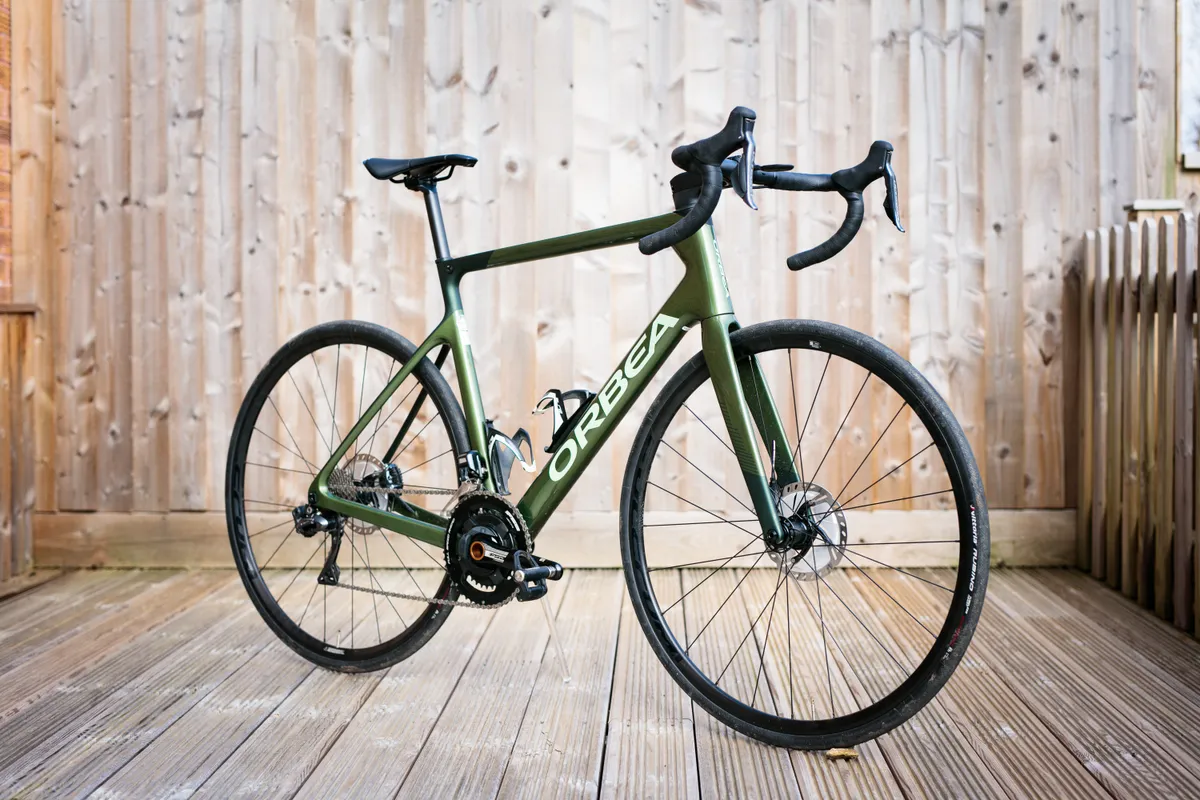
Obviously both can be upgraded using the MyO programme, but the extra cost for better wheels is, unsurprisingly, quite substantial.
The Orca OMR M25 Team model, with its mechanical Ultegra R8000 groupset and 40mm-deep Vision carbon wheels, looks a much more balanced build overall. It’s also over £500 cheaper at the time of writing.
I would consider carefully whether you really need electronic gears. While the performance differential between Di2 and mechanical Ultegra is negligible in most situations, the difference between low-profile and aero wheels, as well as good and bad tyres, can be considerable.
FSA Powerbox alloy impressions
The FSA Powerbox alloy is a spider-based power meter produced in collaboration with German power meter manufacturer Power2Max.
It’s essentially a rebranded Power2Max NGEco, and is available as an optional upgrade on the Orca OMR (and other Orbea road bikes) for a very reasonable £359, or £799 if you want a version with carbon crank arms.
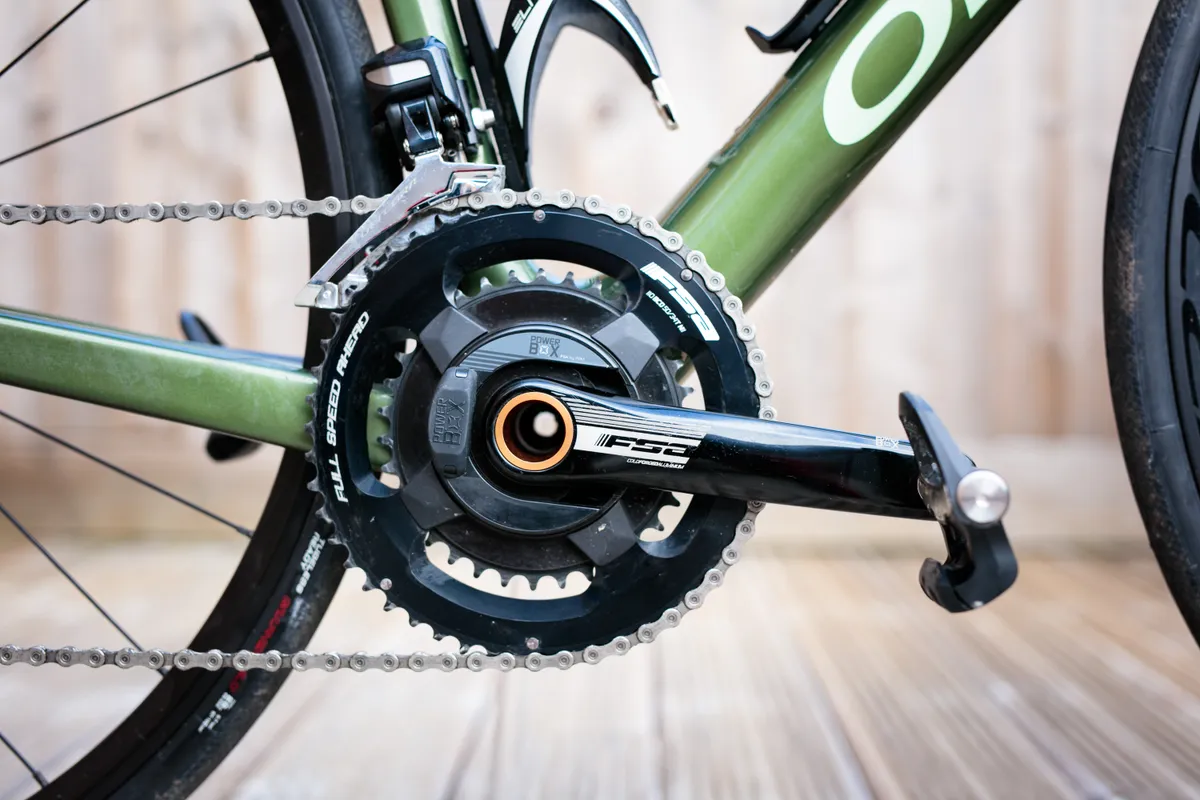
Orbea also offers two chainring combination options – 50/34 teeth or 52 /36 teeth – as well the option to choose between 170mm, 172.5mm or 175mm crank lengths.
It’s admittedly not the prettiest upgrade and it also comes with a weight penalty. The Powerbox alloy weighs 921g, according to FSA, which represents a 236g increase over the 685g Shimano Ultegra R8000 crankset it replaces. The pricer Powerbox carbon, at a claimed 733g, narrows the gap to just 48g.
Whether that weight gain affects the performance of the Orca OMR is dubious, but I’ve no doubt weight weenies will want to take it into consideration.
The Powerbox transmits power and cadence data over both ANT+ and Bluetooth, and, because it’s a spider-based power meter, measures the total power you are producing with both legs (as opposed to single-sided power meters, like the Stages Power L, which take a measurement from one crank arm and double it).
It runs off a single CR2450 coin cell battery and has a claimed life of up to 400 hours. Unfortunately, I didn’t manage to clock 400 hours on this bike during testing, but I haven’t had to replace the battery, so that all looks good.
Accuracy is claimed to be within +/- 2 per cent, and the power data consistently compared well to a set of Garmin Vector 3 power meter pedals throughout my time with it, with quick pick-up and little sensitivity to temperature swings. I’d have no problem using this power meter as a reliable training tool.
Like the Power2Max NGEco power meter it’s based on, features such as estimated left/right power balance and pedal smoothness aren’t included as standard. The unit itself is physically capable of producing this data, but these features are locked behind two optional firmware upgrades, which come at a cost of €50 / $50 each.
To be clear, the extra money is just going on software upgrades here – it doesn’t upgrade the hardware in any way.
These are admittedly more advanced metrics that many amateur cyclists will have little interest in. But, it’s a touch frustrating they’re essentially just hidden behind a paywall.
Nevertheless, this is one of the cheapest ways to get a power meter that measures total power on your bike. £359 is incredibly good value regardless of the optional firmware upgrades. With an RRP of £655 / €734, it also represents a substantial saving versus purchasing an FSA Powerbox separately.
Orbea Orca OMR M20i Team ride quality and handling
Despite its nominal positioning as a race bike with endurance leanings, the lacklustre wheels and tyres, along with the more rounded frame tubes and components, add up to a bike that’s more cruiser than coureur.
The frameset doesn’t lack pedalling stiffness, with the oversized bottom bracket area and chunky seatstays ensuring all of your power reaches the back wheel. It’s likewise plenty stiff through the head tube and fork when wrestling with the handlebar in a sprint, or when climbing out of the saddle.
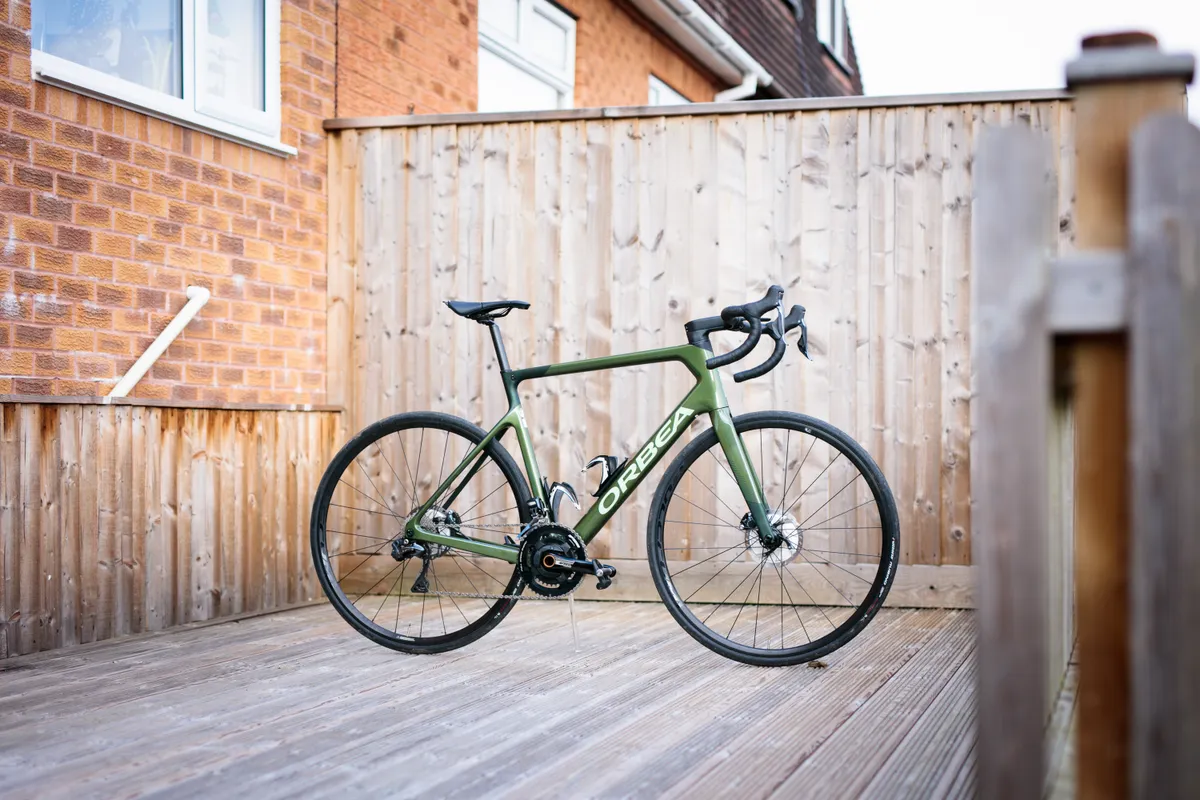
Unfortunately, you have to work hard to get it up to higher speeds and keep it there. At 8.75kg (size 57cm, without pedals or bottle cages) it’s hard to argue that it makes up for its lower levels of aero optimisation on the scales either.
Where the Orca OMR does shine is in its handling characteristics. It always feels composed and smooth, with the Shimano Ultegra hydraulic disc brakes contributing to a feeling of confidence and control when cornering or descending.
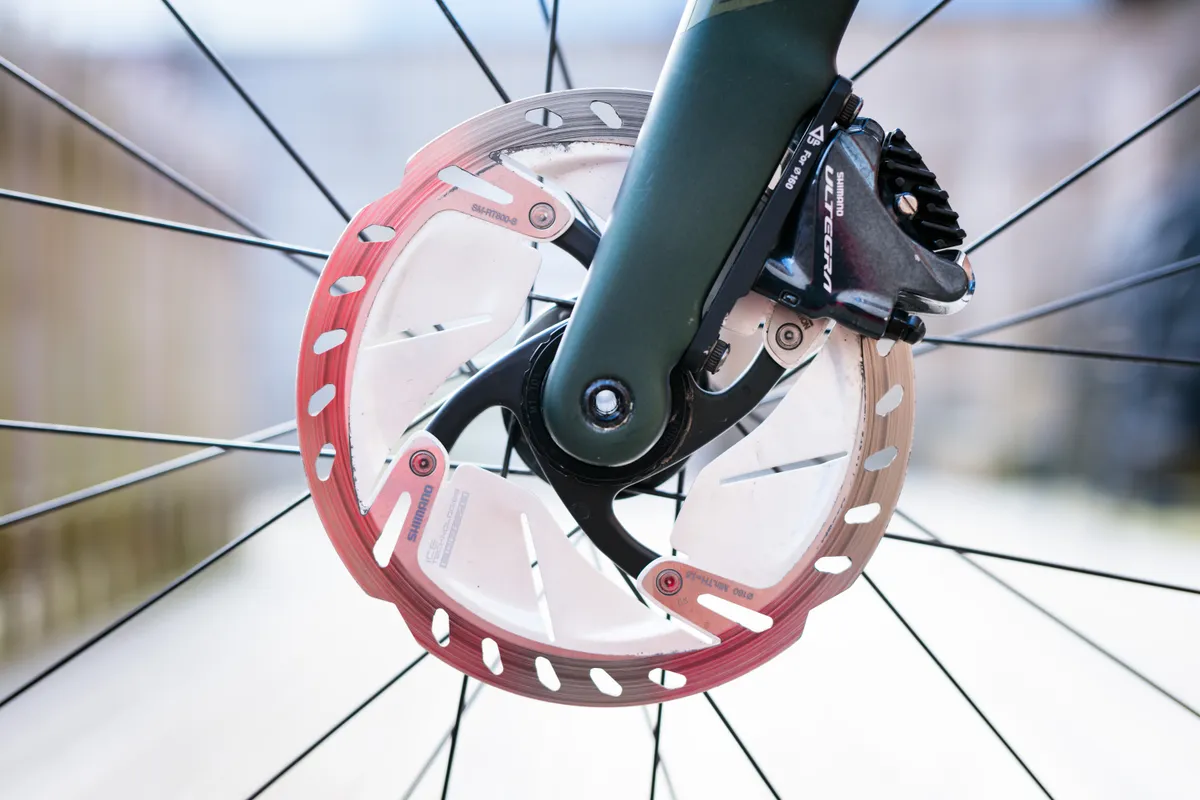
As already mentioned, the Orca OMR shares its geometry with the pricier (and racier) Orca OMX, and its handling impresses in a similar vein.
Orbea says the Orca OMR’s round tubes also offer ten per cent more compliance and vibration absorption than the fully aero-optimised tubes on the Orca OMX, and though I’ve not ridden an OMX myself, ride comfort on the Orca OMR is very good.
It doesn’t feel like you’re riding a bike with suspension, but the Orca OMR soaks up general road buzz really well. You don’t get home feeling beaten up after a few hours on broken roads.
Orbea Orca OMR M20i Team overall
The Orbea Orca OMR M20i Team combines an excellent frameset and components with heaps of tyre clearance.
It’s an easy bike to ride that inspires confidence and doesn’t twitch or surprise with overly snappy responses.
Additionally, the MyO customisation programme is delightful and offers tangible benefits to any cyclist who knows exactly what they want, or simply has a favourite colour.
On the flip side, the Orca OMR’s less aggressive frame shapes, as well as the average wheels and tyres on this specific build, may make it too leisurely for those wanting something with a bit more edge. Though it’s nominally a race bike, it feels like it has more in common with modern endurance road bikes.
That’s not necessarily a bad thing, it’s simply a case of managing your expectations as to where this bike is at its best – which is longer, slower rides on rough roads.
Either way, given a finite budget, I would strongly recommend forgoing electronic gears in favour of a build with mechanical ones, alongside better wheels and tyres, because that would undoubtedly allow the quality of the frameset to shine through much more brightly.
Product
| Brand | orbea |
| Price | 7299.00 AUD,4599.00 EUR,4369.00 GBP,4899.00 USD |
| Weight | 8.7500, KILOGRAM (57cm) - With FSA Powerbox Alloy power meter |
Features
| Fork | Orbea Orca OMR ICR fork 2021 |
| br_stem | Orbea ICR -8º |
| br_chain | Shimano HG 701 |
| br_frame | Orbea Orca carbon OMR Disc |
| Tyres | Vittoria Rubino IV G2.0 TLR 700x28c |
| br_brakes | Shimano R8050 hydraulic disc brakes |
| br_cranks | FSA Powerbox alloy |
| br_saddle | Prologo Scratch-M5 PAS |
| br_wheels | Fulcrum Racing 700 DB |
| br_headset | Acros Alloy 1-1/2" |
| br_shifter | Shimano ST-8070 |
| br_cassette | Shimano Ultegra R8000 11-28T |
| br_seatpost | Orbea OC2 Carbon 27.2 |
| br_handlebar | Orbea OC2 Road Carbon |
| br_bottomBracket | BB386 EVO |
| br_availableSizes | 47cm, 49cm, 51cm, 53cm, 55cm, 57cm, 60cm |
| br_rearDerailleur | Shimano Ultegra Di2 R8050 |
| br_frontDerailleur | Shimano Ultegra Di2 R8050 |
